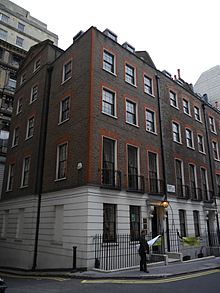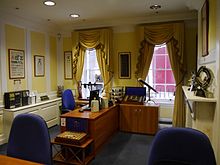
Optometry is a specialized health care profession that involves examining the eyes and related structures for defects or abnormalities. Optometrists are health care professionals who typically provide comprehensive eye care.

The Worshipful Company of Spectacle Makers is one of the Livery Companies of the City of London, UK.
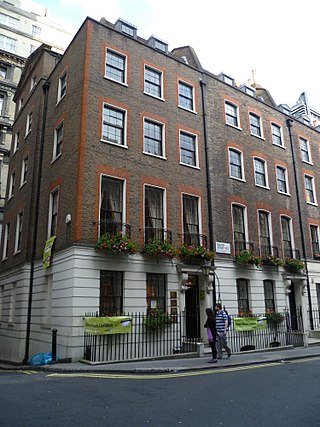
The British Optical Association (BOA) was founded in February 1895 as the first professional body for ophthalmic opticians (optometrists) in the world. The British Optical Association Museum and Library was founded in 1901; it retains the BOA name but is now part of the College of Optometrists, located in Craven Street, Charing Cross, central London.
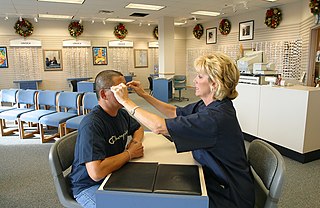
An optician is an individual who fits eyeglasses or contact lenses by filling a refractive prescription from an optometrist or ophthalmologist. They are able to translate and adapt ophthalmic prescriptions, dispense products, and work with accessories. There are several specialties within the field.
The General Optical Council (GOC) is an organisation in the United Kingdom which maintains a register of opticians and regulates the services provided by dispensing opticians and optometrists. The stated function of the GOC is "to protect the public and promote high standards of professional conduct and education amongst opticians".
An eye care professional is an individual who provides a service related to the eyes or vision. It is any healthcare worker involved in eye care, from one with a small amount of post-secondary training to practitioners with a doctoral level of education.
Optometry is a health care profession that provides comprehensive eye and vision care, which includes the diagnosis and management of eye diseases.

The Institute of Optometry is a centre for optometry, based in south London, England. It was established in 1922 as the London Refraction Hospital.

The eye care system in Ghana can be said to be one in its infant or growing stages. Today there are less than 300 eye care professionals taking care of the eye needs of over 23 million Ghanaians.
Henry W. Hofstetter was an American optometrist and the author of two books and 500 research papers. He is a past president of the American Optometric Association and a member of the National Optometry Hall of Fame.
Eye care in the United Kingdom is available through the National Health Service. Eye care in the community is almost entirely provided by optometrists in private practice. Specialist NHS services are provided from a small number of eye hospitals, and their staff often run clinics in general hospitals in their region.

The Association of Optometrists (AOP) is the leading representative membership organisation for optometrists in the United Kingdom.
The Optical Confederation is a British trade association launched in April 2010. It is said to help the optometric profession to "punch well above its weight". Lobbying is one of its key activities. It agrees on advice to opticians with the Department of Health about the administration of NHS sight tests and what fees practitioners can claim. It also issues guidance on professional issues which apply to the entire optical sector, such as the prevention of abuse of vulnerable patients.
Heiko Pult is a German research optometrist, specialising in research in dry eye, contact lenses, tear film and visual acuity. He is the CEO of Horst Riede GmbH in Weinheim, Germany, and also heads a research group, Dr Heiko Pult - Optometry and Vision Research, also based in Weinheim. He is also Professor at Cardiff University, lecturer and author of numerous papers, articles and books.

The European Academy of Optometry and Optics (EAOO) is a membership organization for the development of optometry and optics in Europe. It aims to help in advancing scientific knowledge and learning for optometrists, opticians, and vision scientists, within Europe.
Local Optical Committees are statutory bodies established within the British National Health Service to represent the interests of community optometrists and opticians. There are 78 Local Optical Committees in England. They are supported by the Local Optical Committee Support Unit which provides a link to the national bodies the Association of British Dispensing Opticians, the Association of Optometrists and the Federation of Opticians.
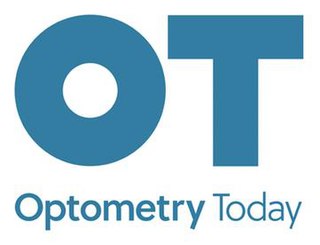
Optometry Today is a professional magazine, published bimonthly by the Association of Optometrists in the United Kingdom.
Clinical and Experimental Optometry is a bimonthly peer-reviewed medical journal covering optometry. As of 2021, the journal has been published by Taylor & Francis on behalf of Optometry Australia, the New Zealand Association of Optometrists, the Hong Kong Society of Professional Optometrists, and the Singapore Optometric Association, of which it is the official journal. Previously it was published by John Wiley & Sons. The editor-in-chief is Professor Nathan Efron.

Epsilon Psi Epsilon (ΕΨΕ) was the first collegiate, professional fraternity for students of Optometry. It continues today on the Ohio State University campus.
The Optometrists and Dispensing Opticians Registration Board of Nigeria (ODORBN) is a government agency responsible for regulating the practice of Optometry and Dispensing Opticianry in Nigeria. It was established by the Optometrists and Dispensing Opticians (Registration, etc.) decree of 1989, now Cap 09 laws of the Federation of Nigeria 2004. The Board evaluates training quality to ensure practitioners acquire the necessary knowledge and skills for their practice, while also ensuring that practitioners conduct themselves lawfully and professionally in their daily activities.
